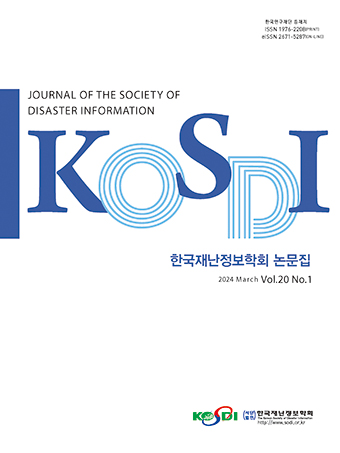Original Article
Abstract
References
Information
Purpose: In this study, the effectiveness of pilot project of PLSP (Priority Lane and Signal Preference) system, which was operated in Cheongju City, was analyzed. Method: The priority signal was operated by a police officer switching to a blue signal when approaching a fire truck through CCTV, and the priority lane of emergency vehicles was displayed on the road to enable preferential traffic. VISSIM simulation analysis was performed for the 1.2km section (3.8km) of the pilot project section and vehicle data was analyzed for some of the test operation sections. Result: Simulation analysis shows that the moving speed of the emergency vehicle can be increased by 42 km/h with the introduction of PLSP, which can be increased by approximately twice the speed. Travel time was reduced by about 3 minutes, and considerable improvements of 69% compared to cities that are not operating was analyzed. The pilot operation of Cheongju City showed a time-shortening effect of about two minutes on average, with the average time reaching 4 minutes and 14 seconds in the first period and the average time reaching 5 minutes and 40 seconds in the second period. Conclusion: The system has been shown to be effective in minimizing time-to-site arrival of emergency vehicles.
연구목적: 본 연구에서는 청주시에 시범운영한 PLSP(Priority Lane and Signal Preemption: 긴급차량 우선신호와 우선차로)제도 사업 효과를 분석하였다. 연구방법: 시범사업 구간(3.8km)을 대상으로 1.2km 구간에 VISSIM 프로그램을 활용하여 시범운영구간의 차량 데이터를 실측 분석하였다. 우선신호의 경우 경찰관이 CCTV로 교차로를 모니터링하여 긴급차량 접근 시 청색신호로 변경하는 방법이 사용되었고, 우선차로의 경우 노면에 긴급차량 우선차로를 표시하여 우선통행이 가능하도록 하였다. 연구결과: 시뮬레이션 분석 결과, PLSP 도입 시 긴급차량의 이동속도는 약 2배 증가한 42km/h로 PLSP 도입 전에 비해 약 3분 가량이 단축되었으며, 기존 대비 69%에 이르는 개선 효과가 있었다. 청주시 시범운영 결과, 평균 도달시간은 1차 기간 4분 14초 2차 기간 5분 40초로 약 2분의 시간 단축 효과가 나타났다. 결론: 본 PLSP 제도는 긴급차량의 현장 도착 시간 단축에 효과적인 것으로 분석되었다.
- Huang, Y,-S,, Shiue, J.-Y., Luo, J. (2015). "A traffic signal control policy for emergency vehicles preemption using Timed Petri nets." IFAC-PapersOnLine, Vol. 48, No. 3, pp 2183-2188. 10.1016/j.ifacol.2015.06.412
- Kim, S.-Y., Ko, K.-Y., Park, S.-Y., Jeong, Y.-G., Lee, C.-K. (2017). "Adaptability analysis of emergency preemption system in field operation." The Journal of The Korea Institute of Intelligent Transport Systems, Vol. 16, No. 3, pp 95-109. 10.12815/kits.2017.16.3.95
- McHale, G.M., John, C. (2003). "Imparoving emergency vehicle traffic signal priority system assessment methodologies." Transportation Research Board 82nd Annual MeetingTransportation Research Board.
- Miyawaki, M., Yamashiro, Z., Yoshida, T. (1999). "Fast emergency pre-emption systems (fast)." Proceedings 199 IEEE/IEEJ/JSAI International Conference on Intelligent Transportation Systems, Tokyo, Japan. 10.1109/ITSC.1999.821199
- Tanaka, Y., Yamada, H., Tamasaku, S., Inaba, H. (2013). "The fast emergency vehicle pre-emption system improved the outcomes of out-of-hospital cardiac arrest." The American journal of emergency medicine, Vol. 31, No. 10, pp. 1466-1471. 10.1016/j.ajem.2013.07.031 24035049
- U.S Department of Transportaion, Office of the Assistant Secretary for Research and Technology Webpages (http://www.itsdeployment.its.dot.gov)
- UTMS society of japan, Funtions and Services of UTMS, FAST(Fast Emergency Vehicle Preemption System) webpages (http://www.utms.or.jp)
- Publisher :The Korean Society of Disaster Information
- Publisher(Ko) :한국재난정보학회
- Journal Title :Journal of the Society of Disaster Information
- Journal Title(Ko) :한국재난정보학회논문집
- Volume : 16
- No :4
- Pages :650-657
- DOI :https://doi.org/10.15683/kosdi.2020.12.31.650




 Journal of the Society of Disaster Information
Journal of the Society of Disaster Information







